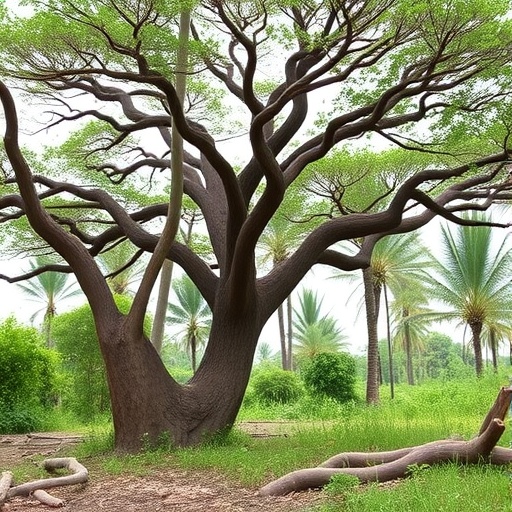In the rich tapestry of Earth’s forests, the guabiroba tree, scientifically known as Campomanesia xanthocarpa O. Berg, plays a crucial role. Nestled within the diverse ecosystem of Mixed Ombrophilous Forests, this tree species presents a fascinating case study of population dynamics, particularly in the context of varying disturbance histories. Recent research published in “Discovering Forests” sheds light on the intricate balance between environmental change and biological resilience, presenting critical insights essential for conservationists and ecologists alike.
The research conducted by Almeida, de Almeida, Tagliari, and colleagues examines how disturbances affect the population dynamics of guabiroba trees. Disturbance events, which can range from natural occurrences like wildfires and floods to human-induced activities such as logging and land conversion, can significantly alter forest composition and health. By exploring these disturbances, the researchers reveal patterns that could have profound implications for forest management practices and biodiversity conservation.
Understanding the population dynamics of guabiroba trees is essential since these trees provide a myriad of ecological benefits, from supporting wildlife to sequestering carbon. The study highlights that these trees possess unique adaptive traits, allowing them to thrive in a variety of environmental conditions. This adaptability is particularly evident when examining how different disturbance histories influence the growth patterns and reproductive success of guabiroba trees over time.
One significant finding of the research is the resilience displayed by guabiroba trees in response to disturbances. Researchers observed that trees in less disturbed areas exhibited a robust population structure, with higher growth rates and reproductive success compared to those in heavily disturbed regions. This finding underscores the importance of minimizing human-induced disturbances to maintain healthy populations of this key species.
Moreover, the study draws attention to the role of forest management practices in shaping population dynamics. By implementing sustainable forestry practices that consider the ecological needs of guabiroba trees, forest managers can enhance the resilience of these forests against emerging threats, including climate change. The researchers emphasize the necessity for policymakers to integrate ecological data into their decision-making processes, ensuring that conservation strategies are grounded in scientific evidence.
The study also explores the genetic diversity of guabiroba trees within different disturbance contexts. Genetic diversity is a critical component of species resilience, acting as a buffer against environmental changes. By analyzing genetic variations among populations, the researchers were able to ascertain how disturbances may have affected the genetic landscape of the guabiroba tree. This knowledge is vital for developing conservation strategies that promote genetic health and adaptive capacity in tree populations.
Furthermore, the research investigates the relationships between guabiroba trees and the broader forest community. These trees not only depend on their environment but also contribute to the overall health of the ecosystem. Their fruits serve as a food source for various animal species, including birds and mammals, thereby facilitating seed dispersal. This reciprocal relationship between guabiroba trees and forest fauna highlights the interconnectedness of biodiversity within mixed ombrophilous forests.
In addition to ecological factors, the study delves into the socio-economic implications of guabiroba trees. As a fruit-bearing tree, guabiroba has potential economic value, particularly in local communities where it may serve as a source of sustenance and income. This dual role of guabiroba trees—as ecological pillars and economic resources—reinforces the need to consider both conservation and community benefits in forest management strategies.
The implications of this research extend beyond the local context, resonating with global forest conservation efforts. As forests around the world face increasing pressure from anthropogenic activities, understanding the population dynamics of key species like guabiroba can inform broad-scale conservation initiatives. By focusing on species resilience and forest health, conservationists can foster ecological stability, crucial to combating climate change and preserving biodiversity.
Importantly, the research points to future avenues of investigation. While the current study provides valuable insights into the population dynamics of guabiroba trees across different disturbance histories, it also raises questions that warrant further exploration. Future studies could address the impacts of climate variability on these dynamics or examine interactions between guabiroba trees and other plant species, thus enriching our understanding of forest ecosystems.
The findings from Almeida and colleagues call for a renewed commitment to studying and preserving the intricate dynamics of forest ecosystems. As scientists continue to unravel the complexities of tree population dynamics, they not only enhance our understanding of specific species like our guabiroba but also contribute to the global discourse on biodiversity conservation.
As we move forward, it is essential that we recognize and act upon the lessons learned from this research. The health of our forests, including the vital guabiroba tree populations, is intricately linked to our actions today. Sustainable management practices, proactive conservation efforts, and increased awareness of the interconnected nature of ecosystems can empower communities and policymakers to safeguard the precious resources that forests provide.
In conclusion, the study on guabiroba trees stands as a testament to the power of scientific research in guiding conservation strategies. As we endeavor to protect our natural ecosystems, embracing the resilience and complexity of species like the guabiroba tree will undoubtedly play a pivotal role in shaping our approach to sustainable forest management in the years to come.
Subject of Research: Population dynamics of the guabiroba tree (Campomanesia xanthocarpa) in relation to disturbance histories.
Article Title: Population dynamics of the guabiroba tree (Campomanesia xanthocarpa O. Berg) in a Mixed Ombrophilous Forest across three disturbance histories.
Article References: Almeida, S.M.Z., de Almeida, L.P., Tagliari, M.M. et al. Population dynamics of the guabiroba tree (Campomanesia xanthocarpa O. Berg) in a Mixed Ombrophilous Forest across three disturbance histories. Discov. For. 1, 42 (2025). https://doi.org/10.1007/s44415-025-00044-x
Image Credits: AI Generated
DOI:
Keywords: Population dynamics, guabiroba tree, Campomanesia xanthocarpa, Mixed Ombrophilous Forest, disturbance history, forest management, biodiversity conservation, ecosystem resilience, genetic diversity, sustainable forestry.




